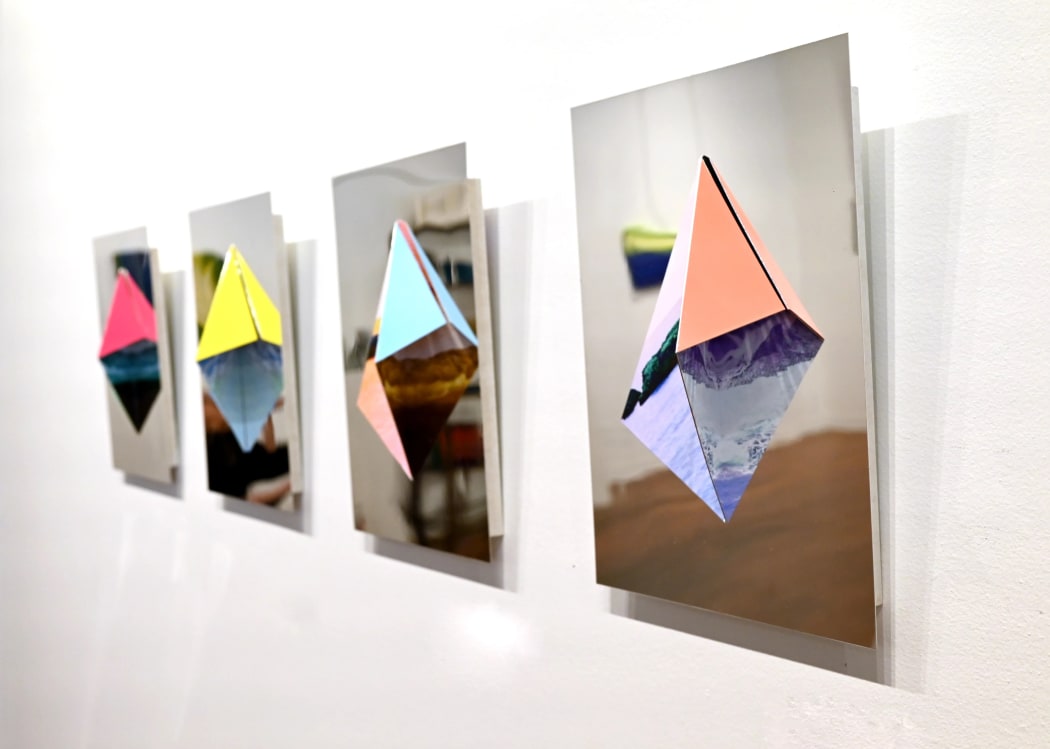
-
What is your approach to photography?
Photography is really just a starting point for my work. I capture landscape photographs but go beyond traditional representations by digitally altering and manipulating them. With this conceptual approach, My hope is to create work that pushes the traditional forms of viewing photography - as 2D art form - where the final artwork goes beyond the initial captured image, transforming it into a whole new space.
2. How do you create your photographic sculptures?
I start by working with just regular paper to decide on the shapes I’d like to use. Once I decide on something, I will draw and measure the same shape, but at a larger scale on a sheet of aluminum. The benefit of using the paper is I can flatten it out so I can see where I need to cut and score the aluminum sheet in order to achieve the shape on a larger scale.
Then I’ll usually keep the shape around for a while until I find the right imagery. After “cooking it up”/altering the image some, I print out a few different versions on adhesive paper. Then i’ll adhere the photos to the cut and scored piece of flat aluminum and bend it into the desired shape.
Everything for my work is very carefully and thoroughly planned. A lot of artists just have to make, experiment, make, fail, etc. until they discover something that sticks. I mostly spend my time thinking about what I want to create before even beginning to cut paper. I’ve always likened my creative process to that of a musical artist. They work behind the scenes for a long period of time before releasing an album full of highly curated songs. Well, it’s the same with me. I’ll work “behind the scenes” on a body of work and won’t really show my work much. And then when the new series is ready, it’ll all just show up at once at a show/exhibition.
3. Where do you find your inspiration?
Repetition and Rhythm are very predominant in the natural world and I think that’s really where I unconsciously find inspiration. Also the idea of combining organic, natural shapes in landscapes with geometric right edges of man-made shapes appeals to me. I’ve always had geometric tendencies.
There’s also always been a color-theory aspect to my work. I typically have a solid color paired with the digitally altered photos. It’s always been a fun, little thing to play with to see how the color changes. And that’s the whole point of color theory - to place colors next to one another and see how it changes the hue/tone and makes colors appear very differently than on their own. It also makes me wonder about the colors the viewer’s experience and how it must be very different for them as well.
4. Let’s deep dive into one of your featured works, Here/There XI. What is this work about and how did you create this work?
I knew I wanted to create a piece that had an image on the inside/ reverse side that would hide and reveal itself as well as could be reflected in the mirrored backing.
I wanted the viewer to feel as though they were looking out over the ocean with this piece. I feel as though they can imagine the photo continuing like an endless landscape but because of the mirror, they are also a part of the landscape/work of art. It creates a unique experience for each viewer and each time the piece is shown, the setting that is reflected changes as well - so it can only be viewed a certain way only once.
-
What direction do you see your work moving forward?
I’m still trying to figure out what I’m doing with this mirror-finish aluminum. I don’t feel like I’ve completely resolved this yet. So I’m planning to keep working with the mirror, dimensional aspect.
And I’ve always gone back and forth between freestanding and wall-hanging sculptural work. So I’m leaning towards creating more free-standing mirrored pieces. At least that’s where my thoughts are leaning right now, but who knows.

